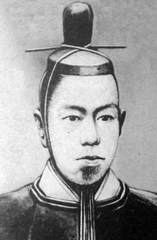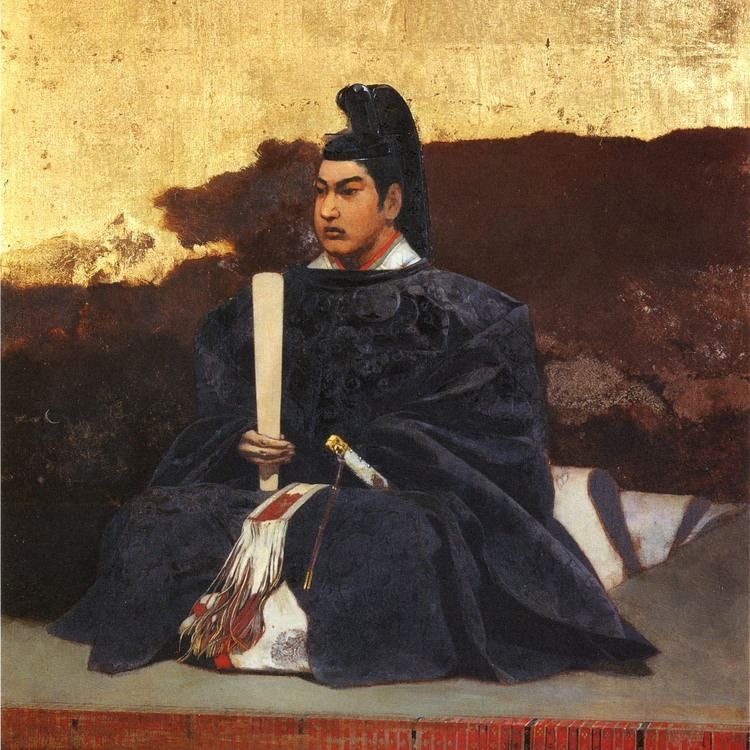Monarch Emperor Komei Name Tokugawa Iemochi | Grandparents Myosoin | |
 | ||
Spouse Chikako, Princess Kazu (m. 1862) Parents Myosoin, Jitsujoin, Tokugawa Nariyuki Similar People Chikako - Princess Kazu, Tokugawa Iesada, Tokugawa Yoshinobu, Emperor Komei, Tokugawa Ienari | ||
Tokugawa Iemochi (徳川 家茂) (July 17, 1846 – August 29, 1866) was the 14th shogun of the Tokugawa shogunate of Japan, who held office from 1858 to 1866. During his reign there was much internal turmoil as a result of Japan's first major contact with the United States, which occurred under Commodore Perry in 1853 and 1854, and of the subsequent "re-opening" of Japan to western nations. Iemochi's reign also saw a weakening of the shogunate.
Contents

Iemochi died in 1866 and was buried in Zojo-ji. His Buddhist name was Shonmyoin.
Biography
Iemochi, known in his childhood as Kikuchiyo (菊千代), was the eldest son of the 11th generation Wakayama Domain lord Tokugawa Nariyuki (1801–1846) with his wife known as jitsujoin and was born in the domain's residence in Edo (modern-day Minato-ku in Tokyo). Nariyuki was a younger son of the 11th shogun, Tokugawa Ienari.
In 1847, at age 1, he was adopted as the heir of the 12th generation daimyo Tokugawa Narikatsu, and succeeded him in 1850, taking the name Tokugawa Yoshitomi following his coming of age in 1851. In 1858 he had audience with Shogun Iesada and his wife, Atsuhime short after he was adopted as their son and named as the successor to the main Tokugawa house. The choice of Yoshitomi was not without conflict; there were other factions in the government who supported Tokugawa Yoshinobu or Matsudaira Naritami for shogun; it must be said that both of them, as opposed to Iemochi, were adults. It was upon assuming the office of shogun that Yoshitomi changed his name to Iemochi.
Before Iesada died he give his will to Ii Naosuke, that:
On 11 February 1862, Iemochi married Princess Kazu, daughter of Emperor Ninko. Princess Kazu didn't use the title "Midaidokoro" because the princess refused to use title "Midaidokoro"; she only used title "Miya".
On April 22, 1863 (Bunkyū 3, 5th day of the 3rd month), Shogun Iemochi traveled in a great procession to the capital. He had been summoned by the emperor, and had 3,000 retainers as escort. This was the first time since the visit of Iemitsu in the Kan'ei era, 230 years before, that a shogun had visited Kyoto.
As part of the kōbu gattai ("Union of Court and Bakufu") movement, Iemochi was married to Imperial Princess Kazu-no-Miya Chikako, daughter of Emperor Ninkō and younger sister of Emperor Kōmei
His early death at the age of 20 put an end to his short marriage with princess Kazu-no-Miya. Before he died he adopted a son, Tayasu Kamenosuke, as his heir. At that time Tayasu Kamenosuke was only 3 years old, but as the Tokugawa shogunate was at war with Satsuma, Yoshinobu was appointed the fifteenth shogun. After Iemochi's death, Kazu-no-Miya changed her name to Seikan'in no Miya. The cause of death is widely reported as heart failure due to beriberi, a disease caused by thiamine (vitamin B1) deficiency.
His successor, Tokugawa Yoshinobu, was the last Tokugawa shogun and witnessed the end of the shogunate, which gave way to the Meiji Restoration.
Family
Eras of Iemochi's bakufu
The years in which Iemochi was shogun are more specifically identified by more than one era name or nengō.
In fiction
Tokugawa Iemochi is featured in the 2008 NHK Taiga drama, Atsuhime. He is portrayed by Matsuda Shota.
His child self is featured in the novel Kazunomiya, Prisoner of Heaven, by Kathryn Lasky, a fictional diary written by Iemochi's wife.
Iemochi is also mentioned in The Last Concubine by Lesley Downer.
He is parodied in the manga and anime series Gin Tama as "Tokugawa Shige-Shige" (徳川 茂茂), with a name based on Tokugawa Ieshige.
Lord Tokugawa appears in James Clavell's novel Gai-Jin as Nobusada Toranaga.
